Social Welfare
The Rise of India’s Aspirational Districts
From the Shadows to the Spotlight
Posted On: 19 MAY 2025 6:28PM
Summary:
- The Aspirational Districts Programme (ADP) was launched in 2018 to uplift 112 underdeveloped districts through data-driven, inclusive governance.
- President Tharman Shanmugaratnam of Singapore praised the ADP as a globally relevant model that empowers communities and strengthens local health systems.
- The Champions of Change Dashboard tracks real-time progress across 49 indicators using a unique “delta ranking” system to promote healthy competition.
- The programme focuses on the “3Cs” approach—Convergence, Collaboration, and Competition—for effective implementation and outcome-driven planning.
- The ADP is positioning India as a global leader in decentralized, inclusive development, offering valuable lessons for other developing nations.
- Since its launch in 2018, the Aspirational Districts Programme has accelerated development across key sectors, with notable progress in health, infrastructure, and agriculture.
Stories of Change
Nestled in the Himalayan foothills, Chamba district in Himachal Pradesh was once a symbol of the challenges that India’s remote regions face—scarce infrastructure, limited connectivity, and a daily struggle for basic amenities. Until a few years ago, only 1 in 5 households had access to tap water. For most families, fetching water meant long treks across hilly terrain, often falling on the shoulders of women and young girls. But today, Chamba tells a very different story.
In February 2022, Chamba became the 100th district in India to achieve “Har Ghar Jal” status under the Aspirational Districts Programme (ADP). Every household now has access to clean tap water—a milestone that has transformed everyday life. Women have been freed from the drudgery of water collection, children fall sick less often, and families have more time and energy to invest in education, livelihoods, and community life.

This achievement is just the beginning of Chamba’s inspiring turnaround. The district now boasts 100% household coverage under the Pradhan Mantri Jan Dhan Yojana (PMJDY), ensuring every family has access to banking and financial services. Fuelled by a mix of strategic incentives and corporate social responsibility (CSR) investments worth crores, Chamba has witnessed growth not only in infrastructure but also in health and nutrition indicators. The integrated efforts have led to a stronger, more resilient community, where development is visible and inclusive. From a district once defined by deprivation, Chamba has emerged as a model of what focused governance, community participation, and data-driven planning can achieve. This remarkable transformation has been largely catalysed by its inclusion in the Aspirational Districts Programme (ADP)—an initiative launched by the NITI Aayog in 2018 to uplift the most underdeveloped districts in India. The Government remains steadfast in its commitment to uplifting the living standards of all citizens and fostering inclusive growth—guided by the principle of “Sabka Saath, Sabka Vikas, aur Sabka Vishwas”. To unlock the full potential of every individual, the programme places a strong emphasis on enhancing people's capacity to actively engage in and benefit from the growing economy.
Gobal Recognition of ADP
It is just one story, there are numerous stories that are hidden in the lanes of Aspirational districts which are becoming example of innovation at the international level. Recently, during the Philanthropy Asia Summit 2025, President of Singapore, Tharman Shanmugaratnam lauded the programme calling it the “interesting example of innovation that can be of interest beyond India, elsewhere in the developing world”.
“If you look at India, one of the unsung successes is what they call the Aspirational Districts Programme. A well-chosen name for the most underdeveloped districts in India. This was Prime Minister Modi's initiative. I believe Gates Foundation joined Piramal Foundation and Tata Trusts in helping to fund it. It gives ownership to the community—developing community health workers, para-nurses, and data systems, supported from the centre – targeted especially at maternal health and health of the child in the earliest years. Monitoring growth, month by month, monitoring nutritional intake, and making sure that circle of actions and remedies is closed at the local level. I've visited some of those districts, and seen how they are working because they give ownership and agency on the ground to the people in the village themselves.”
- Tharman Shanmugaratnam, President of Singapore
A Bold Vision for Balanced Growth
In 2018, the Government of India launched the Aspirational Districts Programme (ADP), a bold initiative designed to transform 112 of the country’s most socio-economically challenged districts into engines of growth and opportunity. The programme’s core philosophy is simple yet profound: shift the narrative from “backwardness” to “aspiration,” and empower districts to realize their latent potential through data-driven governance, collaboration, and healthy competition.
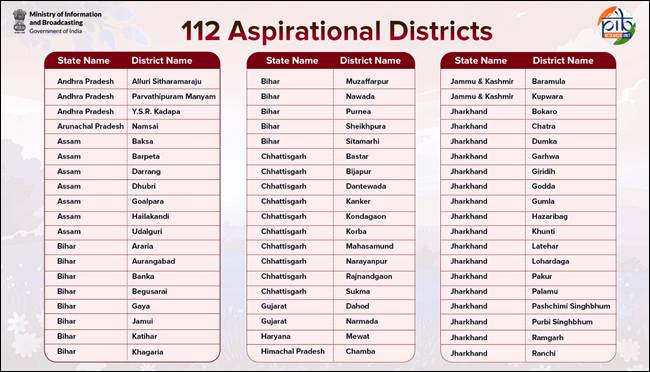
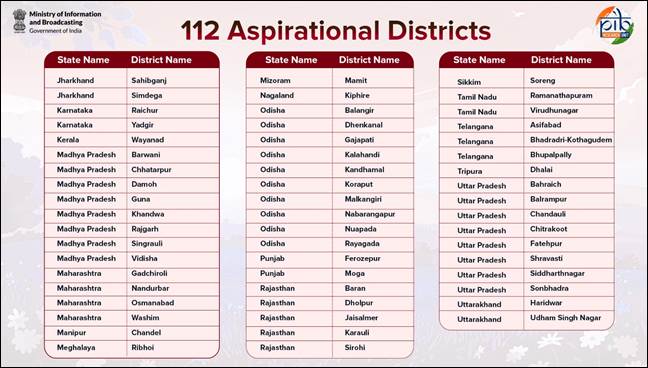
The ADP is anchored by NITI Aayog and operationalized through a unique model built on the “3Cs”: Convergence, Collaboration, and Competition.



Champions of Change Dashboard
What sets the ADP apart is its emphasis on outcomes over inputs. Progress is tracked via the Aspirational Districts Dashboard, a real-time, public platform that scores districts across 49 indicators in five key areas. These indicators are not abstract metrics; they are real-world issues that affect people daily—infant mortality rates, school dropout levels, access to electricity and sanitation, crop productivity, and more.
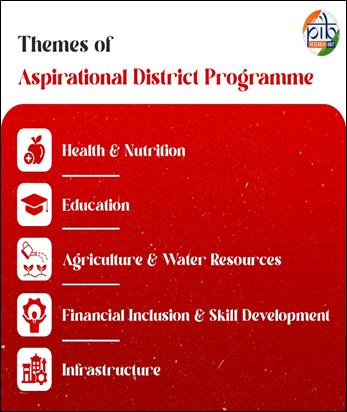
The dedicated portal, Champions of Change Dashboard, uses ‘delta ranking’—a metric that highlights the pace of progress rather than absolute performance. This encourages districts to race against their own past rather than be discouraged by better-off peers.
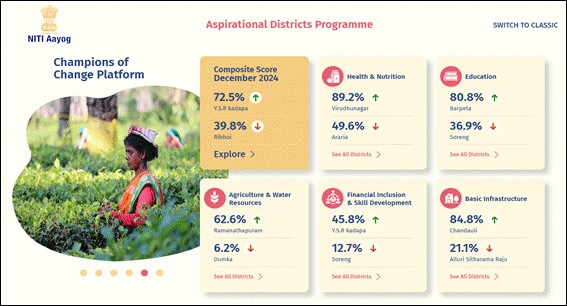
Success and Achievements of ADP
Since it began in January 2018, the Aspirational Districts Programme (ADP) has achieved several important results in improving development in some of India’s most underdeveloped areas. Most of the districts in the programme have shown clear progress, with development happening faster than before. The biggest improvements have been seen in health, nutrition, and basic infrastructure like sanitation, electricity, and clean water, helped by schemes like Swachh Bharat and SAUBHAGYA.
By the end of 2019, in just a year of the beginning of the programme, 8 districts have moved from Tier IV to Tier I category. These districts belong to Bihar, Assam and Chhattisgarh. In the area of Agriculture and Water Resources, only two out of the top ten districts that showed the most improvement were supported by a development partner organisation. This suggests that many districts achieved progress on their own. Notably, Andhra Pradesh stands out in this analysis, with two of its three Aspirational Districts making it to the top ten list, highlighting the state's significant improvement in this sector.
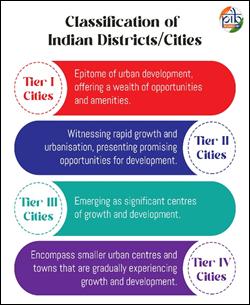
Conclusion: A Model for Transformative Development
The Aspirational Districts Programme stands as a testament to India’s commitment to “Sabka Saath, Sabka Vikas aur Sabka Vishwas”-development for all, with everyone’s trust and participation. By unlocking the potential of its most marginalized regions, India is not only bridging internal divides but also setting a global example for inclusive, data-driven development. As the ADP evolves, its lessons will be crucial for shaping future policies aimed at achieving the Sustainable Development Goals and ensuring that no one is left behind in India’s growth story.
References:
Click here to see PDF.
*****
Santosh Kumar/ Ritu Kataria/ Priya Nagar
(Features ID: 154503)
Visitor Counter : 46
Read this release in:
Hindi